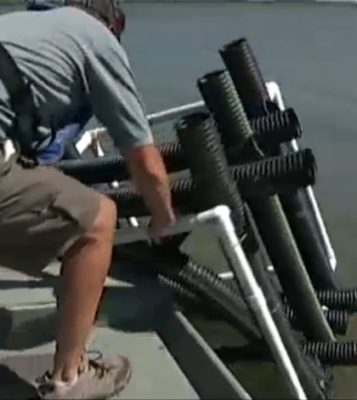Habitat Solutions for Fisheries
 Fish cubes are being added to to Kansas lakes and reservoirs to keep fish populations strong. (Courtesy of KWCH)
Fish cubes are being added to to Kansas lakes and reservoirs to keep fish populations strong. (Courtesy of KWCH)Fishery managers are always trying to find the best way to attract fish and make them comfortable enough in a lake to stick around. The reasoning is simple enough: Happy fish are healthy fish that support recruitment and maintain populations. Fortunately, decades of research have led to a series of strategies that can be used to create fish habitats where shelters are missing.
Habitats serve multiple functions, and as such, it’s important that installed structures also meet the various needs of fish. Suitable habitats meet water quality needs, provide complex structures for shelter and include secure food sources and complimentary spawning grounds. In some cases, natural habitats may fall short on one or multiple characteristics, and fishery managers have to make up the difference.
Types of Fish Habitats
One of the more common strategies is the use of fallen trees or logs to create structures above and below the surface, also known as brush reefs. Gravel beds provide spawning habitat for fish who require loose and flat sediment for spawning—Texas’ Parks and Wildlife Department uses these structures to attract sunfish specifically.
Store-bought structures have also risen in popularity over the years. Items like reef balls and conservation cubes have become more common as they present an easy solution for managers. While some structures require more labor-intensive fashioning, store-bought structures offer convenience.
One of these fashioned items, often referred to as PVC Cubes or Georgia cubes, was developed by the Georgia Department of Natural Resources and has been deployed in several other states since their inception. The cubes are fashioned out of a PVC pipe frame with a plastic corrugated drain pipe looped through it. The pipes are a suitable habitat for both large and small fish who find comfort in different parts of the structure. Larger fish are particularly drawn to these habitats because they can hide in the PVC, waiting for prey fish to swim by, while smaller fish prefer to find shelter in the narrower sections.
Conclusion
Many fisheries have chosen to deploy PVC cubes or other purchased structures for the longevity of the habitat. Brush reefs biodegrade over time and will eventually need to be replaced, while the PVC cubes are designed to last 20-30 years. While it is unclear how these structures will hold up over time, the short-term effects yield more available habitat for fish.
Additionally, many fisheries rely heavily on the support of anglers to keep the fishery running and purchased habitat structures could be a great place for anglers to fish. From a research perspective, having fish gathered in one place can also help make research easier. Population studies and distribution research can also be made easier by these structures.
All of these advancements come at a time when they are most needed. Invasive species and climate change can all lead to habitat loss, so resource managers are left trying to fill in the gaps and restore the habitat.



Pingback: FishSens Magazine | NOAA Fisheries' Annual Review Reveals Continuous Declines in Overfishing - FishSens Magazine